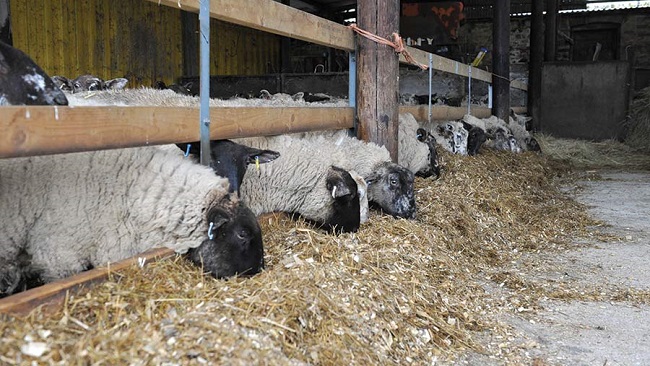
Many sheep producers are looking for alternatives to forages. It is important to consider all the alternatives. Silage is an excellent alternative to hard-to-find high quality hay. Below are some specifics to the preparation as well as the feeding of silage. There are also precautions mentioned for feeding silage to sheep which need to be taken seriously.
Silage
High quality finely chopped (1/4 to 1/2 inch) corn, grass, or small grain silage is acceptable feed for sheep. Care must be taken to properly harvest, store, and feed silage. Poorly packed silage may contain harmful molds, which causes listeriosis (circling disease) in sheep. Moldy or frozen silage should be discarded, and troughs should be cleaned daily. Corn silage is low in protein and calcium. Studies have shown that the addition of 20 pounds of urea, 10 pounds of ground limestone, 4 pounds of di-calcium phosphate, and 5 pounds of calcium sulfate per ton of silage at the time of ensiling makes a complete feed for the ewe flock by increasing its crude protein and calcium content. Alternatively, extra protein, calcium, phosphorous, and vitamins can be supplied through a grain mix top dressed on the silage at the time of feeding. Because of its high moisture content, 3 pounds of silage is required to supply the TDN furnished by 1.5 pounds of hay. The bulkiness of silage prevents adequate dry matter intake and its use as the sole source of feed for ewes in late gestation. A typical diet fed to ewes during the last four weeks of pregnancy on an as fed basis would contain: 6 pounds of corn silage (35 percent dry matter), 2 pounds of hay, 0.5 pound of corn, and 0.25 pound of soybean meal.
Grazing (Gleaning) Corn Fields
With the harvest of corn fields comes the availability of extra corn laying in the fields for such animals as sheep to harvest. Sheep producers should plan to graze (glean) these corn fields with your ewe flock for additional grain and forage during the fall months. Some items to remember include:
- Vaccinate, if needed for Entrotoxemia (overeating disease).
- Fill sheep with hay or grass before turning them into a corn field. This practice will help reduce overeating. Keep hay in with the ewes for several days until they adjust to the corn field diet.
- Introduce slowly to the grain.
- Plan portable fencing to make the field last longer.
- Have access to water, water can be a problem when grazing corn fields due to limited access of water to many of those areas.
An 8-acre field of corn if managed properly, can meet the needs of 100 head of 175-pound ewes for 60 days.
Provided by The Ohio State University School of Veterinary Medicine.
Related Articles & Free Email Newsletter Sign Up
10 Tips to Raise Healthier and More Profitable Sheep
How to Identify and Treat Foot Rot and Foot Scald in Sheep




Comment here